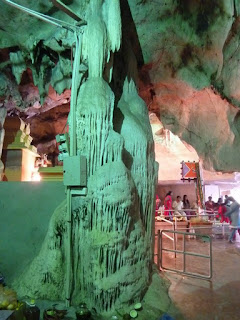Pictorial blogs on some of the interesting caves I have visited around Southeast Asia. On some blogs I have included photos taken over the years.
Although this blog was only born in 2011, I have now included older posts from my Multiply blog which closed in March 2013. This includes articles I have written. I am now also adding news relating to caves I have a particular interest in.
See my website on Caves of Malaysia.
Pages
▼
13 December 2011
Sri Shiva Shanmugar cave temple, Sg Siput
Hong invited me to visit a cave temple festival on Dec 8 2011. As I was unaware of a cave temple in that area I readily agreed. After the visit I realised the cave is in one of the known limestone hills in the Sg Siput (Utara) area of Perak, Malaysia.
There are 4 or 5 small hills and some of the caves are archaeological sites, including Gua Kelawar.
The festival was the 29th Thirukkarthigai for Lord Muruga.
He is the main deity at this Kuil Gua Sri Shiva Shanmugar. Incidentally the main cave temple at Batu Caves is also dedicated to Lord Murugan.
The kuil gua or cave temple is located in the Ladang Sungai Siput which used to be the Phin Soon Estate. The murder of 2 British planters in this estate plus one in the Elphil Estate on June 16, 1948 triggered The Malayan Emergency.
I read on the temple www that it was established in 2002 and completed in 2011.
It was quite a drive in through the plantation. As we approached the temple we stopped to see preparations being done on the chariot, which I guessed would be used that evening.
The cave entrance is in the base of the 40 m hill. There is a noticable flat ledge forming the entrance rock shelter.
The temple arch or gateway was adorned with fruiting banana plants.
In front of the entrance is a tree surrounded by 4 Hindu deities all wearing garlands.
There are about 20 steps leading up to the cave and we left our shoes at the bottom. At the top of the steps is an open rock shelter where people were sitting and relaxing.
Immediately inside the first chamber is a brightly lit shrine to Lord Muruga. A priest was accepting offerings from devotees.
A cave passage led off to the left, with a concrete path and electric lighting.
The passage was lined with large stal throughout and frequently opened up into chambers,
some of which were open to the cliff face.
I particularly liked a large window as it provided a nice frame to a row of large stalagmites beyond.
We passed a colony of insect eating bats that were oblivious to the numerous visitors. There was a water container next to a network of electric cables.
The devotees were all dressed in brightly coloured clothes and it was hard to refrain taking photos.
The festival musicians came down the steps, having finished their ritual in the upper chamber. The path continued up a narrow staircase and there was a bit of a traffic jam with people going up and down.
We reached the upper chamber where the main deity is Shiva.
His statue is a pale grey colour and was bedecked with garlands. His attendant vehicle Nandi was at his feet.
People were lighting oil lamps and burning camphor in his honour. The lamps looked like margarine!
In front of the shrine is a large "bowl" for burning oil and camphor. To the side of the main shrine is a small Ganesh.
I spent time looking out of the view of the surrounding plane, as I could see the other limestone hills and wanted to identify them. I was very surprised to realise that we seemed to be above the main entrance which meant that we had gone right around the hill inside the cave. There were a lot of shells embedded in the floor.
As we made our way back down, we saw people had placed oil lamps throughout the passage. And a small sunbeam was shining in one of the chambers.
Back at the main lower shrine there was a queue of devotees and the temple priest was busy blessing people.
In the main rock shelter area groups were sitting and talking.
Outside hundreds of people were sitting under long awnings eating a banana
leaf vegetarian lunch. The men seemed to be eating with the ladies standing behind.
One man was breaking coconuts for the devotees.
It was a fascinating visit. I am now trying to check if this cave is actually Gol Ba'it which is an archaeological cave reported by Callenfels and Noone in 1940, where human skeletons were found.
© Liz Price
No reproduction without permission














































"I am now trying to check if this cave is actually Gol Ba'it which is an archaeological cave reported by Callenfels and Noone in 1940, where human skeletons were found." Did you managed to find it miss ?
ReplyDeleteI don't think the temple cave is Gol Ba'it. I think Gol Ba'it was in the hill opposite, hill KH. The temple is in hill KF.
DeleteHi sis, this temple legally registered? I mean obtain all approval legally before build.this cave belongs to government or private party?
ReplyDeleteI don't know.
Delete